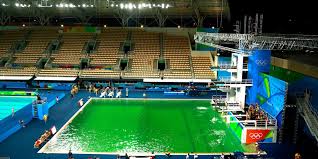Confusion abounded at the Maria Lenk Aquatics Centre as the normally azure pool water turned a swampy green for the women's synchronised 10m platform final.
Divers were forced to compete in water the colour sea lions - rather than Olympians - are accustomed to performing in.
Questions were asked on social media. Had Shrek taken an overnight dip? Was it because Roald Dahl's BFG had been drinking frobscottle?
On Monday, Tom Daley and Daniel Goodfellow had won bronze in then picture-perfect conditions and even Daley did not know what had happened to the clear water he had dived into just 24 hours earlier.

Inside the press room, American photographers chatted about the possibility that the water had not been treated properly overnight, causing a drop in chlorine levels and the formation of algae.
As the competition progressed, the water looked more like pea green soup while the pool next to it - where water polo and synchronised swimming are held - remained in perfect health.
"I've never dived in anything like it," said Britain's Tonia Couch, who finished fifth alongside Lois Toulson.

Couch said the new colour had made it easier to spot where the surface was while they were spinning through the air, insisting it had not impacted on the result.
Once competition was over, organisers released a statement to say that they were still investigating the cause of what was being described on social media as "pool gate".
"It's very important to the Rio 2016 community to ensure a high quality of play," read the statement. "Tests were conducted and the water was found to be safe. We're investigating what the cause was."
On Wednesday, organisers seemed to have solved the mystery, blaming high alkaline levels for the colour change.
source:BBC


Comments